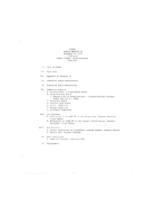Search the Special Collections and Archives Portal
Search Results

Meeting minutes for Consolidated Student Senate, University of Nevada, Las Vegas, November 13, 1979
Date
Archival Collection
Description
Text
Central Nevada Historical Society Photograph Collection
Identifier
Abstract
The Central Nevada Historical Society Photograph Collection (1880-1982) contains photographs from central Nevada towns, mines, and railroads. The photographs primarily depict events and mining operations from the early-twentieth century in or around Tonopah, Goldfield, Belmont, Manhattan, Montezuma, and Big Smoky Valley. The photographs also depict the Tonopah & Goldfield Railroad, the Las Vegas & Tonopah Railroad, the "Priscilla" nuclear bomb test at the Nevada Test Site, horse-drawn freight carriages, and building construction. Other towns also featured in the collection include Silver Peak, Bullfrog, Rawhide, Ellendale, Columbus, Berlin, Palmetto, Gilbert, Blair, Klondyke, Wahmonie, Diamondfield, Miller's, and Candelaria.
Archival Collection
UNLV Libraries Collection of Mandalay Bay Resort and Casino Promotional Materials and Reports
Identifier
Abstract
UNLV Libraries Collection of Mandalay Bay Resort and Casino Promotional Materials and Reports includes annual reports, equity research reports, Securities and Exchange Commission Form 10-K, Securities and Exchange Commission Form 10-Q, press kits, press releases, and promotional materials for Mandalay Bay Resort and Casino in Las Vegas, Nevada, dating from 1996 to 2006.
Archival Collection
History of Nursing in Southern Nevada Oral History Project Records
Identifier
Abstract
The History of Nursing in Southern Nevada Oral History Project Records (1965-2014) are comprised of material related to a volunteer project initiative at the University of Nevada, Las Vegas School of Nursing to conduct oral history interviews with nurses who have practiced in Southern Nevada. The collection contains subject files related to the project, as well as audio, video, and transcript files for the interviews. The collection also includes general information on nursing in Southern Nevada such as research papers and documents from the Nevada Nurses Association.
Archival Collection
Ted Lenhart LGBTQ Community Collection
Identifier
Abstract
The Ted Lenhart LGBTQ Community Collection (1990-2001) is comprised of correspondence, newspaper clippings, and organizational material detailing LGBTQ community issues in Nevada throughout the 1990s. The collection includes materials from organizations including: Aid for AIDS of Nevada, the Clark County Coalition of HIV/AIDS Service Providers, the Nevada chapter of the AIDS Coalition to Unleash Power (ACT-UP), efforts to organize an HIV-Negative Men’s support group in Nevada, and Nevada Outdoors, an LGBTQ hiking club.
Archival Collection
Julian Taber Collection on Gambling Addiction
Identifier
Abstract
The Julian Taber Collection on Gambling Addiction (1977-1988) includes papers, proposals, internal reports, memoranda, and newspaper articles chronicling the work of Julian Taber, an early specialist in the field of gambling addiction. The majority of the collection relates to Taber’s work and pilot programs at the Brecksville Veterans Administration (VA) Hospital in Brecksville, Ohio, with select materials pertaining to an alcohol dependency treatment program he coordinated at the VA hospital in Reno, Nevada.
Archival Collection

Transcript of interview with Frank H. Johnson by George Baker, February 21, 1980
Date
Archival Collection
Description
On February 21, 1980, George Baker interviewed Frank H. Johnson (born July 27th , 1929 in El Paso, Texas) about his occupational history in Southern Nevada. The two discuss Johnson’s career as a journalist for the Nevada State Journal and how he transitioned into his position as a government official. Johnson then recalls problems that arose while he was chairman of the Nevada Gaming Commission. The interview concludes with Johnson speculating about the impact of industrial growth on the environment.
Text

Transcript of interview with Eldon Cunningham by Randall L. Williams, March 14, 1981
Date
Description
On March 14, 1981, Randall Williams interviewed Eldon Cunningham (born 1920 in Granby, Missouri) about his life in Las Vegas, Nevada. Cunningham first talks about his family background, his reason for moving to Las Vegas, and his service in the military during World War II. He also mentions the Twin Lakes area of Las Vegas, his hobby of prospecting, and his work with Clark County Electric as an electrician. Cunningham also talks in detail about some of his experiences while working at the Nevada Test Site in electrical work. As the interview concludes, Cunningham talks more about family illnesses, experiments at the Test Site, and his former hunting practices.
Text

Transcript of interview with Russell K. Grater by James M. Greene, November 25, 1974
Date
Archival Collection
Description
On November 25, 1974, collector James M. Greene interviewed Russell K. Grater (born November 16th, 1907 in Lebanon, Indiana) in his home in Boulder City, Nevada. This interview offers an overview of the United States Park Service. Mr. Grater also offers an overview on the history of housing developments in the Las Vegas Valley and Nelson Township. The interview concludes with discussion on the leaf system of local plants.
Text

Transcript of interview with Kate Hausbeck Korgan by Claytee White, February 3, 2010
Date
Archival Collection
Description
Kate Hausbeck Korgan was raised and educated in Buffalo, New York. In 1995, after receiving her doctorate in sociology from University of Buffalo, her job search brought her to the University of Nevada, Las Vegas. It was a great fit and she tells of falling in love with the school, the city, and the John S Park Neighborhood. Kate retells the story of the house where she and her family reside. It's original owners were the Gambles who built the house in 1936. It was the second house built in the neighborhood and is the only inhabited adobe house in the city. The house is located on the fringe of John S. Park Neighborhood, about a block off the Strip. Though the location creates traffic that she doesn't like, it is not enough to cause her to move. She describes the newer generation of residents and the changes as the number of school aged children increased. Kate's perspective includes what she describes as the ebb and flow of the community, the beginning of First Fridays, the
Text
